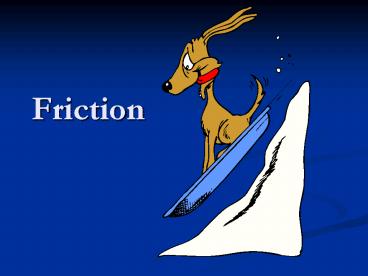Friction - PowerPoint PPT Presentation
1 / 15
Title:
Friction
Description:
This is the key to non-skid brakes. Applied Force, N. Frictional Force ... Now, solve the same problem using non-skid brakes so the wheels keep turning ... – PowerPoint PPT presentation
Number of Views:281
Avg rating:3.0/5.0
Title: Friction
1
Friction
2
Friction
- Friction causes objects to slow down.
- Friction creates heat.
- Friction degrades an objects energy
3
Static Friction
Normal force
Applied Force
Friction, Resistance
- Objects at rest.
- Applied force is insufficient to move object.
Weight mg
4
Friction
- Surface imperfections and micro-welds.
5
Static Friction
- Increases linearly
- For a given pair of surfaces, the ratio of
Frictional force to Applied force is a constant.
Frictional Force
Applied Force
6
Static Friction
- The relationship is
- µs force of friction/normal force.
- Where µ is called the coefficient of static
friction. - It has no units and varies between 0 and 2 in
general. We usually rearrange the equation - Ffs µs FN
7
Example of Static Friction
- What is the coefficient of static friction
between a tabletop and a 2 kg block of wood if a
2 N force is required to start the block moving?
- Identify knowns and unknowns
- m 2 kg
applied force 2 N,
- v 0
- µs ?
8
- Appropriate equation Ff µ FN.
- What is FN?
On a level surface the normal force upward is
equal to the weight of the object downward, i.e.
FN m(-g)
FN Fg mg
Ff µFN
Ff µ mg or
µ f/mg
Fg mg
2 N/(2 kg 9.8m/s2)
µ 0.102
9
Kinetic Friction
- The word kinetic stems from the Greek word,
kinema meaning motion, so kinetic friction deals
with the friction present when motion is
occurring. - The resistance is less because the microscopic
impediments are being sheared off and no time for
micro-welds to form.
10
Kinetic Friction
- Constant
- Less than static friction.
- This is the key to non-skid brakes.
Frictional Force
Applied Force, N
11
Compare skidding with no skidding.
- A car moving at 25 m/s slams on its brakes. The
coefficient of static friction with the road is
1.2 and the kinetic coefficient is 0.4 How far
does the car slide?
Equations v2 v02 2 ad Fnet ma FN mg Ff µ
FN
Knowns vo 25 m/s v 0 m/s µs 0.4. Unknown
d ?
12
Free body diagram for skidding
Direction of car ()
FN m(-g)
Ff µk FN
Fg mg
Fnet Ff
13
Solve for a from net force equation
Solve for d
Vf2 v02 2ad
Fnet ma a fnet/m
d - v02 /2a
Substitute in for a d -v02 / 2(Fnet/m)
-v02m/2Fnet
Since Fnet Ff
-v02m/2Ff
14
AND.
Ff µk FN
FN Fg mg
-v02m/2µ FN
SO
-v02m/2µ mg
(-25m/s)2 -.4(9.8m/s2)
15
- Now, solve the same problem using non-skid brakes
so the wheels keep turning while the car slows
down. In this case we use the state coefficient
of friction - x vo2/2µg
- (25 m/s)2/(20.859.8 m/s2)
- 37.5 m
- Imagine if the pavement wear wet and the
coefficient of kinetic friction was 0.47. The
stopping distance would be nearly 75 m!































